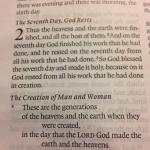The first three days of creation make the earth inhabitable. God creates light the first day, distinguishes sky from the waters below on the second, and causes dry land to emerge on the third. The earth is no longer “formless.”
The second set of three days fill the “void.” In the second set of days, each day corresponds to one of the previous three days of creation. On the fourth day the sun, moon, and stars relate to the creation of light on the first day. The birds and fish created on day five fill in the form that exists because of the sky and the sea. Finally God creates plants, animals, and humans on day six and they live on the dry land which God created on the sixth day.
The writer aims to show that God created an orderly and good world. After all, God proclaims the goodness of each thing that He has created. Many of the ancient creation myths treat the creation of the world as an accident. In these myths, creation is unfortunate and chaotic. Genesis 1 paints a dramatically different picture. God created the world with a purpose and it is good.
Verses 26 and 27 introduce readers to crown of creation. While some may scoff at this designation, the retelling of the creation of human beings differs from the rest of creation. God deliberates with Himself saying that He will create human beings “in our image and our likeness.” While we should not read a full-blown doctrine of the Trinity into this verse, it does point to plurality within the Godhead. That God creates humans in His image makes them different from the rest of creation. They represent Him on earth, subduing the earth and producing more image bearers who will subdue the earth and cultivate it. Humans know God and relate to Him in a way that the rest of creation doesn’t.













